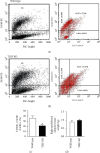TIR-Domain-Containing Adaptor-Inducing Interferon- β (TRIF) Is Involved in Glucose Metabolism in Adipose Tissue through the Insulin/AKT Signaling Pathway
- PMID: 33376487
- PMCID: PMC7744180
- DOI: 10.1155/2020/6942307
TIR-Domain-Containing Adaptor-Inducing Interferon- β (TRIF) Is Involved in Glucose Metabolism in Adipose Tissue through the Insulin/AKT Signaling Pathway
Abstract
Obesity significantly increases the risk of developing type 2 diabetes mellitus and other metabolic diseases. Obesity is associated with chronic low-grade inflammation in white adipose tissues, which is thought to play an essential role in developing insulin resistance. Many lines of evidence indicate that toll-like receptors (TLRs) and their downstream signaling pathways are involved in development of chronic low-grade inflammation and insulin resistance, which are associated with obesity. Mice lacking molecules positively involved in the TLR signaling pathways are generally protected from high-fat diet-induced inflammation and insulin resistance. In this study, we have determined the effects of genetic deficiency of toll/interleukin-1 receptor-domain-containing adaptor-inducing interferon-β (TRIF) on food intake, bodyweight, glucose metabolism, adipose tissue macrophage polarization, and insulin signaling in normal chow diet-fed mice to investigate the role of the TRIF-dependent TLR signaling in adipose tissue metabolism and inflammation. TRIF deficiency (TRIF-/-) increased food intake and bodyweight. The significant increase in bodyweight in TRIF-/- mice was discernible as early as 24 weeks of age and sustained thereafter. TRIF-/- mice showed impaired glucose tolerance in glucose tolerance tests, but their insulin tolerance tests were similar to those in TRIF+/+ mice. Although no difference was found in the epididymal adipose mass between the two groups, the percentage of CD206+ M2 macrophages in epididymal adipose tissue decreased in TRIF-/- mice compared with those in TRIF+/+ mice. Furthermore, activation of epididymal adipose AKT in response to insulin stimulation was remarkably diminished in TRIF-/- mice compared with TRIF+/+ mice. Our results indicate that the TRIF-dependent TLR signaling contributes to maintaining insulin/AKT signaling and M2 macrophages in epididymal adipose tissue under a normal chow diet and provide new evidence that TLR4-targeted therapies for type 2 diabetes require caution.
Copyright © 2020 Junling Yang and Ken-Ichiro Fukuchi.
Conflict of interest statement
The authors have no conflicts of interest to declare.
Figures




Similar articles
-
TLR4, TRIF, and MyD88 are essential for myelopoiesis and CD11c+ adipose tissue macrophage production in obese mice.J Biol Chem. 2018 Jun 8;293(23):8775-8786. doi: 10.1074/jbc.RA117.001526. Epub 2018 Apr 10. J Biol Chem. 2018. PMID: 29636416 Free PMC article.
-
Role of the TLR signaling molecule TRIF in β-cell function and glucose homeostasis.Islets. 2010 Mar-Apr;2(2):104-11. doi: 10.4161/isl.2.2.11209. Islets. 2010. PMID: 21099302
-
Adipose tissue exosome-like vesicles mediate activation of macrophage-induced insulin resistance.Diabetes. 2009 Nov;58(11):2498-505. doi: 10.2337/db09-0216. Epub 2009 Aug 12. Diabetes. 2009. PMID: 19675137 Free PMC article.
-
Innate sensors of pathogen and stress: linking inflammation to obesity.J Allergy Clin Immunol. 2013 Aug;132(2):287-94. doi: 10.1016/j.jaci.2013.06.022. J Allergy Clin Immunol. 2013. PMID: 23905917 Review.
-
Macrophages, Low-Grade Inflammation, Insulin Resistance and Hyperinsulinemia: A Mutual Ambiguous Relationship in the Development of Metabolic Diseases.J Clin Med. 2022 Jul 27;11(15):4358. doi: 10.3390/jcm11154358. J Clin Med. 2022. PMID: 35955975 Free PMC article. Review.
Cited by
-
The role of hypothalamic endoplasmic reticulum stress in schizophrenia and antipsychotic-induced weight gain: A narrative review.Front Neurosci. 2022 Sep 16;16:947295. doi: 10.3389/fnins.2022.947295. eCollection 2022. Front Neurosci. 2022. PMID: 36188456 Free PMC article. Review.
References
-
- Adeva-Andany M. M., Fernandez-Fernandez C., Carneiro-Freire N., Castro-Quintela E., Pedre-Pineiro A., Seco-Filgueira M. Insulin resistance underlies the elevated cardiovascular risk associated with kidney disease and glomerular hyperfiltration. Reviews in Cardiovascular Medicine. 2020;21(1):41–56. doi: 10.31083/j.rcm.2020.01.5102. - DOI - PubMed
Grants and funding
LinkOut - more resources
Full Text Sources

